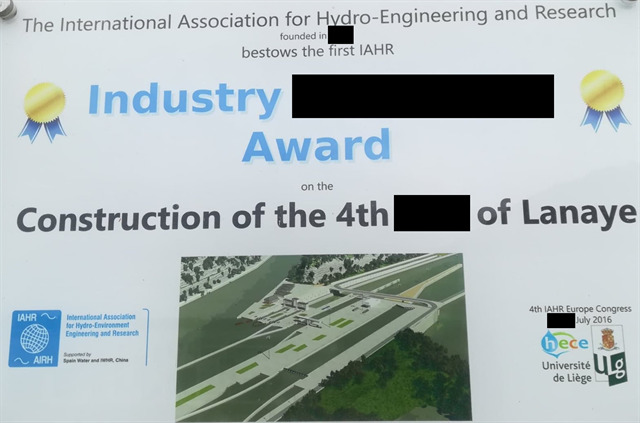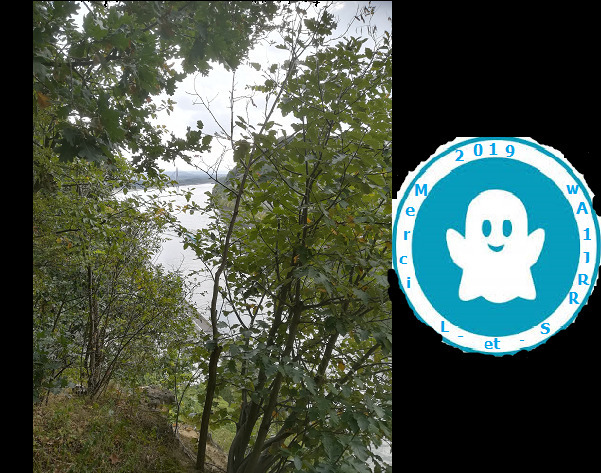

Texte en français:
La L-et_S team et l'écluse:
Cette écluse, nous la traversons fréquemment (le plus souvent en voiture, car mon Yacht n'est pas adapté à la Meuse...) lorsque nous nous rendons à Maastricht pour le marché du vendredi. Sur place nous profitons souvent de notre présence pour :
- Aller manger dans un restaurant asiatique où mon grand-père se rendait souvent.
- Acheter du tissu pour les créations de la L de L-et-S.
- ...
Pour en revenir à l'écluse, j'ai souvent trouvé cet endroit joli. Un béton moderne qui se mélange à la roche de la montagne St Pierre pour réaliser un beau paysage...
Informations:
Les écluses de Lanaye sont un ensemble d’écluses situé en Belgique à la frontière néerlandaise faisant la jonction entre le Canal de Lanaye et le Canal Albert, à Lanaye (ville de Visé) dans la province de Liège. La plus grande des 4 écluses, inaugurée en 2015 pour permettre le passage de bateaux de 9.000 tonnes, offre les dimensions de 225 mètres de long, 25 mètres de large et une dénivellation de 13,68 mètres Les écluses situées à la frontière entre la Belgique et les Pays-Bas sont appelées le bouchon de Lanaye parce que ces écluses, qui datent des années 1960, sont trop petites pour les exigences de la circulation fluviale croissant entre Liège et Rotterdam : deux petites écluses (55 X 7,5 mètres) pour bateaux de 600 tonnes jouxtent une écluse plus grande (136 X 16 mètres) pour bateaux de 2.000 tonnes. Un accord de collaboration avec les Néerlandais a été obtenu en 2001. Une quatrième écluse de 25 mètres de large est en construction à cheval sur les Pays-Bas et la Région wallonne depuis 2004, ce qui permettra de faire passer des convois de quatre barges poussées, contre deux dans une écluse de 18 mètres.
LES TRAVAUX DE CONSTRUCTION DE LA 4ÈME ÉCLUSE DE LANAYE, LONGUE DE 225 MÈTRES ET LARGE DE 25 MÈTRES, ONT DÉMARRÉ EN JUIN 2011 ET SE SONT TERMINÉS EN JUIN 2015. LE SITE ÉCLUSIER DE LANAYE COMPTE ÉGALEMENT TROIS AUTRES ÉCLUSES CONSTRUITES DANS LES ANNÉES 60 : UNE ÉCLUSE DE 136 X 16 MÈTRES ET DEUX ÉCLUSES DE 55 X 7,5 MÈTRES (QUI NE SONT PLUS EN SERVICE).
A côté de la nouvelle écluse, une station de pompage a été construite pour compenser la consommation moyenne des écluses du site en période d’étiage (basses eaux). Une centrale hydroélectrique y a été associée pour produire de l’électricité renouvelable lorsque, a contrario, le débit de la Meuse le permet D’autres aménagements ont été effectués pour intégrer la nouvelle écluse dans le respect de son environnement : Création d’une zone favorisant la reproduction de certaines espèces Construction d’un mur destiné à protéger l’apparition d’orchidées sauvages Plantation d’un verger Réalisation de cheminements piétons et cyclistes Aménagement d’un chainon manquant du RAVeL Situé à cheval sur la Belgique et les Pays-Bas, le complexe éclusier de Lanaye est un carrefour fluvial stratégique de première importance : il constitue un lien essentiel permettant aux bateaux d’accéder à la Meuse néerlandaise et aux grands ports de Rotterdam et d’Amsterdam, ainsi qu’à l’ensemble des bassins du Rhin et du Danube vers l’Allemagne.
CHIFFRES-CLÉS Au total, le coût global du chantier s'est élevé à 153.000.000 € dont : 115.000.000 € financés par la SOFICO, maître d'ouvrage du chantier, avec l'aide d'un prêt de la Banque Européenne d'Investissement (BEI) 28.000.000 € financés par la Commission européenne dans le cadre du programme RTE-T, le réseau transeuropéen de transport 10.000.000 € financés par les Pays-Bas
Loguer la cache :
Afin de loguer cette cache, nous vous demandons de :
WP 1:
- Prendre obligatoirement une photo de vous (visage optionnel) avec la vue de la montagne St Pierre et de la Meuse côté Pays-Bas (Obligatoire).
- Sur cette photo, il peut y avoir un bateau que vous aurez apporté avec vous (Optionnel). Celui-ci peut-être en papier, en plastique, en bois, un simple dessin, un jouet, ... (Optionnel) Soyez Créatif !
- Si l'occasion se présente ( On se situe ici sur un axe navigable fort fréquenté), nous aimerions que sur votre photo il y ait aussi un vrai bateau en arrière plan (Optionnel).
WP 2:
Complètez le texte manquant. Il manque une date et 3 mots.

Merci de m' envoyer vos réponses par mail où par la messagerie de geocaching.com. Ne divulguer pas de réponses dans vos logs :-)
Virtual Rewards 2.0 - 2019/2020
Ce cache virtuel fait partie d'une version limitée de logiciels virtuels créés entre le 4 juin 2019 et le 4 juin 2020. Seuls 4 000 propriétaires de cache ont eu la possibilité de masquer un cache virtuel. En savoir plus sur Virtual Rewards 2.0 sur le blog de géocachette .


Tekst in het nederlands:
Het L-et_S team en de sluis:
Deze sluis passeren we vaak (meestal met de auto, omdat mijn jacht niet is aangepast aan de Maas ...) wanneer we naar Maastricht gaan voor de vrijdagmarkt. Op de site profiteren we vaak van onze aanwezigheid voor:
- Ga eten in een Aziatisch restaurant waar mijn grootvader vaak ging.
- Koop stof voor L-en-S L creaties.
- ...
Om terug te gaan naar de sluis, vond ik deze plek vaak mooi. Een modern beton dat zich mengt met de rots van de berg St Pierre om een prachtig landschap te creëren ...
Informatie:
De sluizen van Lanaye zijn een reeks sluizen in België aan de Nederlandse grens die de kruising vormen tussen het Lanaye-kanaal en het Albertkanaal, in Lanaye (stad van Visé) in de provincie Luik. De grootste van de 4 sluizen, ingehuldigd in 2015 om boten van 9.000 ton te laten passeren, biedt de afmetingen van 225 meter lang, 25 meter breed en een hoogteverschil van 13,68 meter De sluizen op de grens tussen België en Nederland worden de Lanaye-kurk genoemd omdat deze sluizen uit de jaren zestig te klein zijn voor de eisen van het toenemende rivierverkeer tussen Luik en Rotterdam: twee kleine sluizen (55 x 7,5 meter) voor boten van 600 ton grenst aan een grotere sluis (136 x 16 meter) voor boten van 2000 ton. In 2001 werd een samenwerkingsovereenkomst gesloten met de Nederlanders. Sinds 2004 is een vierde sluis van 25 meter breed in aanbouw tussen Nederland en het Waalse Gewest, waardoor konvooien van vier duwbakken kunnen worden gepasseerd. , tegen twee in een sluis van 18 meter.
HET BOUWWERK VAN HET 4E SLOT VAN LANAYE, LANG VAN 225 METER EN GROOT VAN 25 METER, BEGONNEN IN JUNI 2011 EN BEËINDIGD IN JUNI 2015. DE SITE ÉCLUSIER DE LANAYE BOEKT OOK DRIE ANDERE LICHTEN GEBOUWD IN DE 60S: EEN SLOT VAN 136 X 16 METER EN TWEE LICENTIES VAN 55 X 7,5 METER (DIE NIET MEER IN GEBRUIK ZIJN).
Naast de nieuwe sluis werd een pompstation gebouwd om het gemiddelde verbruik van de sluizen van de site tijdens perioden met laag water te compenseren. Een waterkrachtcentrale is in verband gebracht om hernieuwbare elektriciteit te produceren wanneer de stroom van de Maas het toelaat Andere aanpassingen zijn gedaan om het nieuwe slot te integreren met betrekking tot zijn omgeving: Creatie van een gebied dat de reproductie van bepaalde soorten bevordert Bouw van een muur om het uiterlijk van wilde orchideeën te beschermen Een boomgaard planten Realisatie van voetgangers- en fietsroutes Verbetering van een ontbrekende RAVeL-keten Het sluiswachterscomplex van Lanaye, dat België en Nederland overspant, is een strategisch rivierkruispunt van groot belang: het is een essentiële verbinding waarmee boten toegang krijgen tot de Nederlandse Maas en de grote havens van Rotterdam en Amsterdam, evenals alle Rijn- en Donau-stroomgebieden naar Duitsland.
KERNCIJFERS In totaal waren de totale kosten van het project € 153.000.000 inclusief: 115.000.000 € gefinancierd door SOFICO, projecteigenaar, met behulp van een lening van de Europese Investeringsbank (EIB) 28.000.000 € gefinancierd door de Europese Commissie in het kader van het TEN-T-programma, het trans-Europese vervoersnetwerk 10.000.000 € gefinancierd door Nederland
Log de cache:
Om deze cache te loggen, vragen wij u om:
WP 1:
- Moet een foto van u maken (optioneel gezicht) met uitzicht op de St Pierre-berg en de Maas Nederland (verplicht).
- Op deze foto kan er een boot zijn die u hebt meegenomen (optioneel). Deze misschien in papier, in plastic, in hout, een eenvoudige tekening, een stuk speelgoed, ... (Optioneel) Wees creatief!
- Als de gelegenheid zich voordoet (we zijn hier op een drukke waterweg), willen we graag dat er op uw foto ook een echte boot op de achtergrond staat (optioneel).
WP 2:
Vul de ontbrekende tekst in. Er ontbreekt een datum en 3 woorden.

Bedankt voor het sturen van je antwoorden per e-mail of per e-mail van geocaching.com. Maak geen antwoorden bekend in uw logboeken :-)
Virtual Rewards 2.0 - 2019/2020
Deze virtuele cache maakt deel uit van een beperkte versie van virtuele software die is gemaakt tussen 4 juni 2019 en 4 juni 2020. Slechts 4.000 eigenaren cache kon een virtuele cache verbergen. Meer informatie over Virtual Rewards 2.0 op het geocachingblog .


English text:
The L-et_S team and the lock:
This lock, we cross frequently (most often by car, because my yacht is not adapted to the Meuse ...) when we go to Maastricht for the Friday market. On site we often take advantage of our presence for:
- Go eat in an Asian restaurant where my grandfather went often.
- Buy fabric for L-and-S L creations.
- ...
To get back to the lock, I often found this place pretty. A modern concrete that mixes with the rock of the St Pierre mountain to create a beautiful landscape ...
Information:
The locks of Lanaye are a set of locks located in Belgium on the Dutch border making the junction between the Lanaye Canal and the Albert Canal, in Lanaye (city of Visé) in the province of Liège. The largest of the 4 locks, inaugurated in 2015 to allow the passage of boats of 9,000 tons, offers the dimensions of 225 meters long, 25 meters wide and a difference in height of 13.68 meters The locks on the border between Belgium and the Netherlands are called the Lanaye cork because these locks, which date back to the 1960s, are too small for the demands of the increasing river traffic between Liège and Rotterdam: two small locks (55 X 7.5 meters) for 600 tons boats adjoin a larger lock (136 X 16 meters) for boats of 2,000 tons. A cooperation agreement with the Dutch was obtained in 2001. A fourth lock of 25 meters wide is under construction straddling the Netherlands and the Walloon Region since 2004, which will allow convoys of four pushed barges to be passed. , against two in a lock of 18 meters.
THE CONSTRUCTION WORK OF THE 4TH LOCK OF LANAYE, LONG OF 225 METERS AND LARGE OF 25 METERS, STARTED IN JUNE 2011 AND ENDED IN JUNE 2015. THE SITE ÉCLUSIER DE LANAYE ALSO ACCOUNTES THREE OTHER LIGHTS BUILT IN THE 60s: A LOCK OF 136 X 16 METERS AND TWO LICENS OF 55 X 7,5 METERS (WHICH ARE NO LONGER IN SERVICE).
Next to the new lock, a pumping station was built to compensate for the average consumption of the locks of the site during low water periods. A hydroelectric plant has been associated to produce renewable electricity when, conversely, the flow of the Meuse allows it Other adjustments have been made to integrate the new lock in respect of its environment: Creation of an area promoting the reproduction of certain species Construction of a wall to protect the appearance of wild orchids Planting an orchard Realization of pedestrian and cyclist routes Improvement of a missing RAVeL chainon Straddling Belgium and the Netherlands, the lock-keeper complex of Lanaye is a strategic river crossroad of major importance: it is an essential link enabling boats to access the Dutch Meuse and the major ports of Rotterdam and Amsterdam, as well as all the Rhine and Danube basins to Germany.
KEY FIGURES In total, the overall cost of the project was € 153,000,000 including: 115,000,000 € financed by SOFICO, project owner, with the help of a loan from the European Investment Bank (EIB) 28,000,000 € financed by the European Commission under the TEN-T program, the trans-European transport network 10,000,000 € financed by the Netherlands
Log the cache:
In order to log this cache, we ask you to:
WP 1:
- Must take a picture of you (optional face) with the view of the St Pierre mountain and the Meuse Netherlands (Required).
- In this photo, there may be a boat that you brought with you (Optional). This one maybe in paper, in plastic, in wood, a simple drawing, a toy, ... (Optional) Be Creative!
- If the opportunity arises (We are here on a busy waterway), we would like that on your photo there is also a real boat in the background (Optional).
WP 2:
Complete the missing text. It is missing a date and 3 words.

Thank you for sending me your answers by email or by mail from geocaching.com. Do not divulge any answers in your logs :-)
Virtual Rewards 2.0 - 2019/2020
This virtual cache is part of a limited version of virtual software created between June 4, 2019 and June 4, 2020. Only 4,000 owners cache were able to hide a virtual cache. Learn more about Virtual Rewards 2.0 on the geocaching blog .

